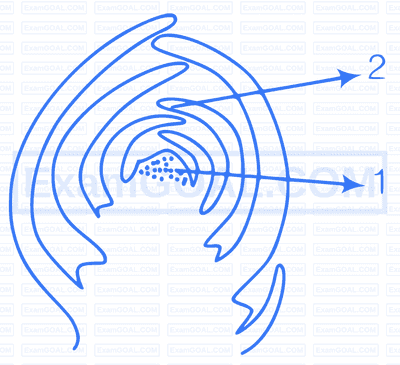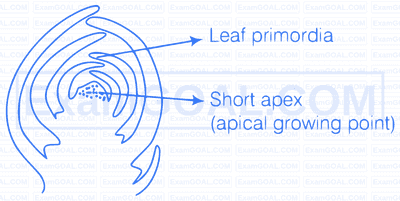38
A rubber band stretches and reverts back to its original position. Bubble gum stretches, but it would not return to its original position.
Is there any difference between the two processes? Discuss it with respect to plant growth (hint elasticity (reversible) plasticity (irreversible).
Explanation
| Elasticity | Plasticity |
|---|---|
| The elasticity is stretchability of the plant cells or products, e.g., rubber/latex etc. The elastic substances can revert back to its original form in relaxed state. e.g., stretching of rubber. |
Different pathways in response to environment or phases of life to form different kinds of structure is called plasticity. The plastic substances and phenomenon of plasticity are not reversible, i.e., irreversible. e.g., difference in shapes of leaves produced in air and those produced in water in buttercup. This is also known as heterophylly. |
39
Label the diagram
A. This is which part of a dicotyledonous plants?
B. If we remove part 1 from the plant, what will happen?

Explanation
Representation the labelling of the given diagram is as follows

A. The plant part in the given diagram is growing shoot apex.
B. Removal of shoot apex will help to overcome the apical dominance. Thus, the lateral buds grow faster, giving rise to branches and give the plant a bushy appearance.
40
Both animals and plants grow. Why do we say that growth and differentiation in plants is open and not so in animals? Does this statement hold true for sponges also?
Explanation
Growth and differentiation in plant and animals can be explained as follows
| Growth in Plants | Growth in Animals |
|---|---|
| Plant growth is indeterminate, i.e., cells can divide and enlarge continuously for life time. |
Animal growth is determinate i.e., till finite period, they mature and stop growing externally. |
| Growth is open due to presence of meristematic cells which keep dividing, i.e., growing and replacing new organs. | Cell division is distributed through-out the body of organism to replace old and damaged cells, rather localised at specific regions. |
| Structure in plants at tips or meristematic zones is never complete, owing to open ended tips or apices. | After a specific time period i.e., embryonic, the growth rate is reduced in juvenile phase and ceases in maturity. |
| Plant growth is in a modular fashion, i.e., grows longitudinally, laterally and in grith. |
Sponges are exception to this. They show open growth as every cell of their body can give rise to an individual and their growth and differentiation is continuous is their life cycle.
41
Define parthenocarpy. Name the plant hormone used to induce parthenocarpy.
Explanation
Parthenocarpy is the process where fruit develop without fertilisation and so, it does not contain seed. This can also be induced artificially by spraying auxin and gibberellins in certain plants like, grapes, papaya, etc.
42
While eating watermelons, all of us wish it was seedless. As a plant physiologist can you suggest any method by which this can be achieved.
Explanation
The process of parthenocarpy produce the seedless fruits. This is a process in which fruits are developed without fertilisation, so, seeds are not formed in the fruit. Artificially parthenocarpy can be induced by spraying auxin and gibberellin to produce seedless watermelans.